If you think the beauty of the Brazilian landscapes is only limited to the shores, then we must get you acquainted with some of the best waterfalls in the country. Expect a lot of green, watching the wild life in their element, and of course, refreshing waterfalls you can jump in.
From the gorgeous Santa Bárbara waterfall in Chapada dos Veadeiros to the world-famous Iguazu Falls, there are plenty of rapids for you to visit in Brazil. Even if you’re not a fan of massive bodies of water, there are still options if you just want to chill by a little cascade.
In this post, we will take a look at the 10 best waterfalls in Brazil, go over what is the best time of the year to go to each of them, where they are located, the best way to get to all of them, and everything you need to know so you can start planning your trip to the country!
1. Cachoeira da Fumaça – Chapada Diamantina (BA)
Admittance Fee: around USD 30.00-40.00 per person (depending on the agency)
Opening Hours: every day from 8 AM to 5 PM
Difficulty Level: medium
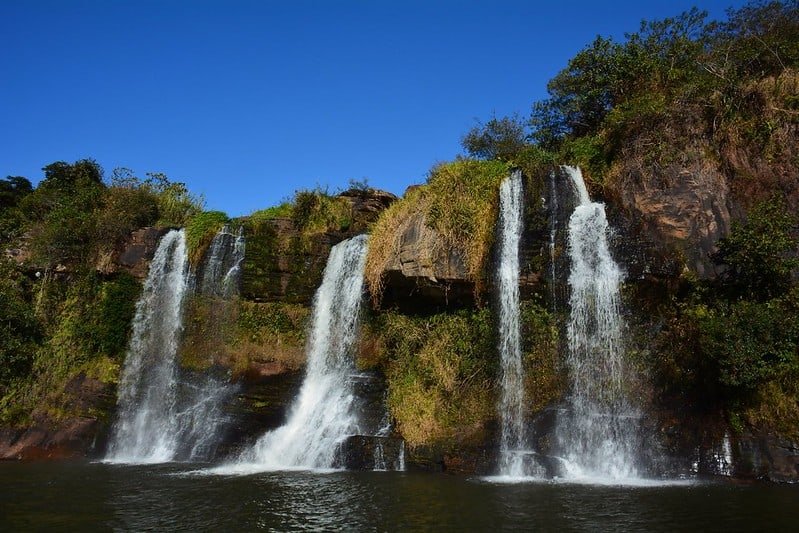
When you stare at the Fumaça Waterfalls, it is easy to understand why they say it is one of the most beautiful landscapes in the Chapada Diamantina region. The waterfall is over 1100 feet, surrounded by a beautiful rock formation that feels like a paradise in the middle of the exuberant nature of the Capão Valley.
It’s hard not to think about how small we are in front of the Fumaça Waterfalls as well, as it is considered one of the largest in Brazil. For that reason, it can be visited both from below and above. The most common tour is the one that leads you to see the waterfall from above. But saying it’s common doesn’t mean it will be a smooth ride.
The Cachoeira da Fumaça trail is among one of the most exhausting of the day trips at Chapada Diamantina. Altogether, you will be persevering through 12 miles of trekking (both legs), and the first mile is locally known for requiring a lot of breath and physical preparation of visitors.
But, once the initial stage is passed, the rest of the journey is much easier and enjoyable, and once you get a full view of the Cachoeira da Fumaça at the end, it will surely be worth all the effort!
Best Time Of The Year To Visit Chapada Diamantina
The region can be visited at any time of the year, but if the focus of your trip is on the waterfalls then the best time to go to Chapada Diamantina is during the Summer. Although the period is indeed a bit rainy (which muddy the trails), the waterfalls get much fuller and beautiful.
Best Way To Get To Chapada Diamantina / Cachoeira da Fumaça
The best way to go to Chapada Diamantina is by landing at the Salvador International Airport (Dep. Luís Eduardo Magalhães – SSA), taking a bus to Lençóis, which is the small village from which you will be taking the tour rides to Chapada Diamantina.
2. Cachoeira de Santa Bárbara – Chapada dos Veadeiros (GO)
Admittance Fee: around USD 20.00 per person
Opening Hours: every day from 7 AM to 5 PM
Difficulty Level: easy
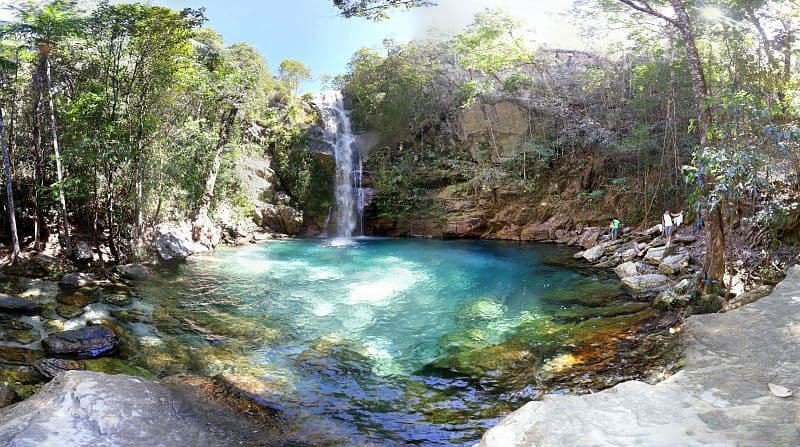
One of the most beautiful waterfalls among tourists in the region, the Santa Bárbara Waterfall has already become one of the main attractions of Chapada dos Veadeiros. The water shimmers in various shades of light blue, which gives the place a bit of a Caribbean flair. The waterfall is not really that high (98 feet) and the environment of the well that surrounds the waterfall is very Instagrammable.
To visit Cachoeira Santa Bárbara, it is mandatory to hire a guide. The most common thing is to hire one of the Kalunga residents available at the Tourist Service Center in the village of Kalungas Engenho II, which we will go on more about in a future topic.
The tour service is pretty well-organized and the guides work on a “first-come, first-served” type of arrangement. You will be paying for a standard tour and the price could go up depending on the number of waterfalls visited on the day’s itinerary.
It is worth mentioning that there is a visit limitation at the Santa Bárbara Waterfall on busy days, in which visitors are only allowed to stay for an hour. But, if you want to stay longer, my advice would be to avoid weekends, holidays, school vacation periods, and getting there early in the day, when there are fewer chances of having people there!
Best Time Of The Year To Go To Chapada dos Veadeiros
The best time to go to Chapada dos Veadeiros is at the beginning of the rainy season, between September and October. The drought period will be over, the waterfalls begin to regain strength and there are very few risks of major storms.
Best Way To Get To Chapada dos Veadeiros
The best way to get to Chapada dos Veadeiros is by landing at Brasília International Airport (BSB) and then renting a car to get to Chapada dos Veadeiros.
From Brasília to Cachoeira Santa Bárbara you will be traveling about 196 miles on the BR-010 route until you reach the city of Cavalcante, which is where you will be purchasing your tickets to visit the waterfall. You can buy your ticket to the Santa Bárbara Waterfall (and to other waterfalls in the Quilombo Kalunga region) on their website.
It is advisable for you to buy your ticket in advance because to preserve the Santa Bárbara Waterfall, there is a restriction on access, in which a maximum of only 300 people is allowed per day. Every hour, only 50 people can enter simultaneously, so guarantee your spot so you won’t miss out!
3. Cachoeira do Tabuleiro – Parque Municipal Natural do Tabuleiro (MG)
Admittance Fee: around USD 2.00
Opening Hours: every day from 8 AM to 9 PM
Difficulty Level: medium

The Tabuleiro Waterfall is housed by the Tabuleiro County National Park (Parque Municipal Natural do Tabuleiro), located at the Conceição do Mato Dentro district in Minas Gerais. Aside from being rich in biodiversity, the main highlight of this 1k feet high waterfall is the fact that it has the shape of a heart.
The wall with reddish tones and the lush green fields definitely places the Tabuleiro Waterfall amongst the most beautiful in the country. At the top of the waterfall, there are other smaller falls and natural pools, several of them suitable for bathing.
In the lower portion, there is an incredible 60-feet deep well in which you most likely won’t resist diving in. If you like hiking and trekking, then you won’t be disappointed here, as there are many ways to get to the waterfall. The most popular route goes from Lapinha to the Tabuleiro district, but we will get to that on a future topic.
It is important to stress that you need to be careful when diving in the large well of Cachoeira do Tabuleiro, due to the presence of large submerged rock formations. There is also a constant wind current and the incidence of sunlight is low, which will contribute significantly to a cooler local climate. So don’t forget to bring a towel and a change of clothes!
Best Time To Go To Parque Municipal Natural do Tabuleiro
If you want to enjoy it up close, the best time to go to the Tabuleiro Waterfall at Parque Municipal Natural do Tabuleiro is during the dry season, between the months of April and November. During the remaining months, you could be looking at getting a bit of rain, which could make this amazing sight less fun.
Best Way To Get To Parque Municipal Natural do Tabuleiro
The best way to get to the Tabuleiro County Natural Park is by landing at the Belo Horizonte International Airport (Aeroporto Internacional de Confins – CNF), and then either taking a bus to Conceição do Mato Dentro, or renting a car and driving there yourself.
If you choose the latter, you must drive around 60 miles along the MG-010 highway to Serra do Cipó. Then, you will be driving another 55 miles to the city of Conceição do Mato Dentro. The waterfall is about 9 miles from the city’s downtown area and it should take you around 3 hours from Belo Horizonte to the waterfall.
4. Salto do Itiquira – Parque Municipal do Itiquira (GO)
Admittance Fee: around USD 2.00
Opening Hours: every day from 9 AM to 5 PM, last entries at 4 PM
Difficulty Level: easy
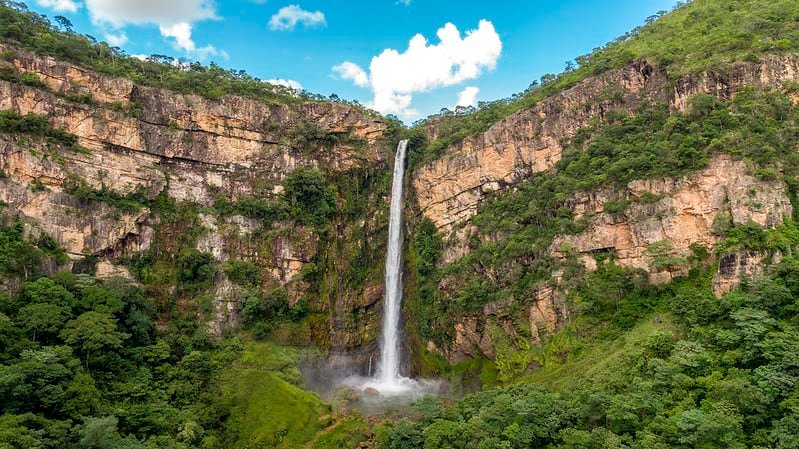
The Salto do Itiquira waterfall is a 550 feet-high waterfall housed by the Formosa district in Goiás, Midwest of Brazil. Being the eighth largest waterfall in Brazil, Salto do Itiquira is located within a protected area (the Municipal Park of Itiquira), and due to the strength of the waterfall, bathing is not allowed in its well.
If you happen to be visiting the parking during a sunny day, then there are high chances of you sighting a gigantic rainbow that forms around the waterfall. And if you venture into some of the trails around, you will be able to contemplate the beauties of nature, the natural pools, lush green, and the sunset.
And if you are worried about having to face some treacherous trail to get there, we have good news for you! The trip to Salto do Itiquira is perfect for those who want to see a beautiful waterfall, but are not exactly keen on the idea of going full-Survivor mode to reach it. The trail here is very easy and quick, as you will be walking a 15 minutes distance on a paved path to get there.
Best Time To Go To Parque Municipal do Itiquira
The best time to go to Parque Municipal do Itiquira to see the Salto do Itiquira waterfall is undoubtedly during the dry season, which runs from April to early September. The skies are blue, you will be facing very little rain and the sunset is absolutely incredible.
Going between mid-September and March you will need to count on your luck to experience a sunny day. The rains are much more frequent and you will certainly not be able to fully enjoy the Salto do Itiquira waterfall as you should.
Best Way To Get To Parque Municipal do Itiquiera
The best way to get to Parque Municipal do Itiquiera is by landing at the Brasília Internation Airport (BSB) and then taking a tour bus or renting a car to complete the rest of the trip. The waterfall is located around 9 miles from Brasília and if you decide to drive there, you just need to take the BR-20 highway and follow a well-signed path to the Park’s entrance.
5. Salto São Francisco – Serra da Boa Esperança (PA)
Admittance Fee: free
Opening Hours: every day from 8 AM to 5:30 PM
Difficulty Level: medium
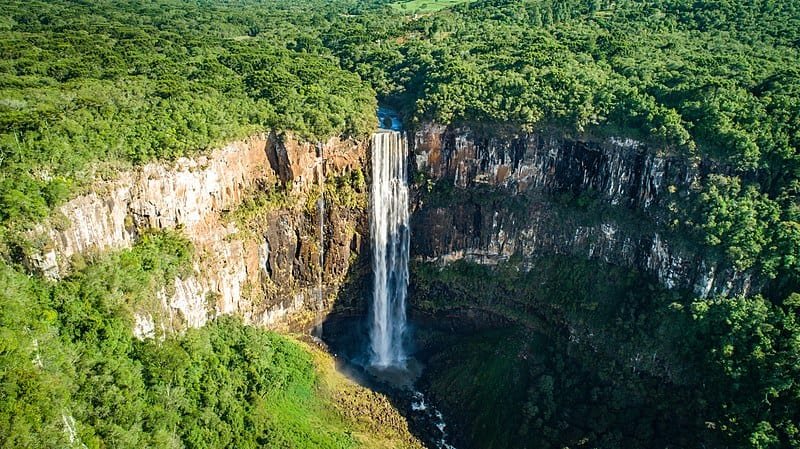
Salto São Francisco is the largest waterfall in southern Brazil and one of the largest in the country as well. It is located in Serra da Boa Esperança, right in between the Guarapuava, Prudentópolis, and Turvo districts, in the state of Paraná.
It’s impossible not to drop your jaw when you get sight of Salto de São Francisco, especially after noticing how the water is turned into mist, even before it hits the ground. While this is the largest in the region (over 640 feet-hight), there is another large fall in the area, which is the Salto dos Cavalheiros (500 feet high).
Once you get to the park, you can choose to go on two different trails:
- the upper trail will lead you the main viewpoint of the São Francisco waterfall. You will walk about less than a mile through a paved path, where you’ll get to a spot in which you will be able to get a clear frontal view of the waterfalls and the canyons around it.
- the lower trail will lead you to the São Francisco Waterfall’s well and it is much harder, as it will take you about 2 hours to go down and 3 hours to go back up. The trail is pretty clear and you hardly will get lost in it, but it requires good physical preparation. The final stretch is done on the riverbank amidst many rocks and uneven stretches, which could makes things even more tiresome.
Best Time To Go To Serra da Boa Esperança
The best time to go to Serra da Boa Esperança is from May to September, in which you most likely won’t be facing the rain and there are fewer chances of bad weather at the São Francisco Waterfall.
Best Way To Get To Serra da Boa Esperança
The best way to get to Serra da Boa Esperança is by landing at the Paraná International Airport (Aeroporto Internacional Afonso Pena – CWB/SBCT) and then taking a travel bus or renting a car to Guarapuava. Once you are in the city, the access road to the São Francisco Waterfall is through the BR-277 highway.
The entrance to the Waterfall road can be located just before the Botanical Garden, and you will be driving about 30 miles on a narrow (but paved) road, in which only the last 4 miles or so are on a dirt road.
6. Cascata do Caracol – Parque Estadual do Caracol (RS)
Admittance Fee: around USD 3.00
Opening Hours: every day from 8:45 AM to 5:45 PM
Difficulty Level: medium

Cachoeira do Caracol is a 426 feet high waterfall housed by the Caracol State Park, located about 4,5 miles from the city of Canela (which we have previously talked about in this post). The landscape here is absolutely beautiful, so make sure you have your phone charged for some amazing snapshots.
Inside the park, you can take the aerial cable car tours to take you all the way up to Cachoeira do Caracol. The ride is pretty exciting, as you will be stopping in two different stations along the way. On the first, you will be able to walk a small trail with signs identifying the fauna and flora of the region. On the second station, you will get an amazing view of the Caracol Waterfall and the valley around it, so if you want
But if that’s not enough adrenaline for you, then you must try the zipline ride over the Caracol Waterfall, which is located right in the middle of the aerial cable car stations. If you are brave enough, you will be gliding through a 600 feet distance while being 13 feet above the waterfall, which sounds pretty exciting, huh?
You can also climb down the staggering 927-steps ladder that leads to the bottom of the waterfall, just be careful if you are visiting on a rainy day, as the steps can get pretty slippery and dangerous.
The Caracol State Park is a pretty nice place to visit overall, as it disposes of a playground for children, barbecue grills, trails, a gazebo, a picnic area, and, of course, a beautiful view of the Cascata do Caracol so you can spend a full day in the middle of nature.
Best Time To Go To Parque Estadual do Caracol
The best time to go to Parque Estadual do Caracol to visit the waterfall is during the Summer, between the months of December and March. Although the weather (and temperature) is less favorable during the Winter, it is also possible to visit the park during that season, as you could take the opportunity to visit Canela and Gramado as well.
Best Way To Get To Parque Estadual do Caracol
The best way to get to Parque Estadual do Caracol is by landing at the Porto Alegre International Airport (Aeroporto Internacional Salgado Filho – POA), and then taking the tour bus or driving to Canela or Gramado, which are the nearest cities. Both cities are about 5 miles apart, so it’s just a matter of you figuring out which one fits you better.
7. Iguazu Falls (Cataratas do Iguaçu) – Parque Nacional do Iguaçu (PA)
Admittance Fee: around USD 15.00
Opening Hours: from Tuesday to Sunday, 9 AM to 4 PM
Difficulty Level: medium
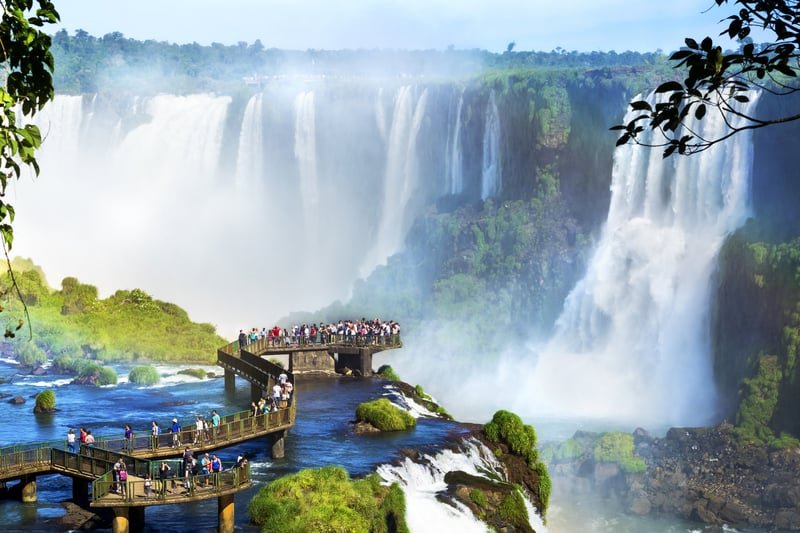
The Iguaçu Falls are largely known worldwide and visited by tourists from all over the world. Located at the border between Brazil and Argentina, the Iguaçu National Park has more than 270 falls and a part of its territory is housed by the Brazilian state of Paraná (South of the country).
The strength of the waters and the immensity of the falls are the main responsible for enchanting the visitors. One of the most famous waterfalls is called Garganta do Diabo, which is just under 500 feet wide and 260 feet high. This waterfall has one of the largest water flows of all the falls on the Brazilian side of the park
The Iguazu Falls are one of the natural heritage of humanity, and since the park is located in a gigantic area, the transport inside is done in a very comfortable double-decker bus — part closed, part open. This is a great thing for those who are not physically prepared to face a trail but still want to get a sight of the waterfalls.
But if you are up to the task, you could walk a little under a mile on the Cataratas Trail, and take beautiful pictures of the falls on your way there, while meeting coatis, birds, or butterflies along the way. The trail also has several viewpoints, but it is not advisable for those not used to physical activities.
Best Time To Go To the Iguazu Falls
If the idea is to see the waterfalls at their maximum potential and with a lot of volumes, the best time of the year to go to the Iguazu Falls is during the summer. But if you would prefer to see the actual shapes of the falls, then it is best to go in winter. But honestly, the falls are an incredible spectacle all year long, so it’s just a matter of when is the best timing for you.
Best Way To Get To the Iguazu Falls
The best way to get to the Brazilian side of the Iguazu Falls is by landing at the Foz do Iguaçu International Airport (Aeroporto Internacional de Foz do Iguaçu – IGU) and then taking a travel bus or renting a car to the Iguazu National Park.
The bus ride can be a bit uncomfortable on your way back, as a lot of people decide to leave at the last minute to enjoy the place a bit more, which caused the buses to get crowded. So if you are looking for comfort and autonomy, your best bet would be to rent a car and drive there yourself.
8. Salto do Yucumã – Parque Estadual do Turvo (RS)
Admittance Fee: around USD 5.00
Opening Hours: from Thursday to Monday, 8 AM to 5 PM
Difficulty Level: easy
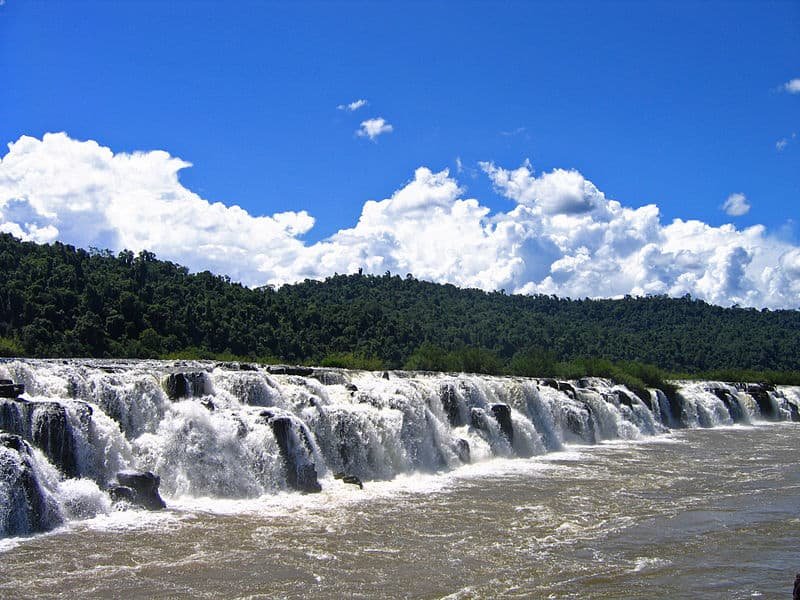
The Salto do Yucumã waterfall is considered the longest longitudinal drop in the world, with over a mile in length. The height of the falls varies according to the water level of the Uruguay River, reaching up to 65 feet and the average depth of the channel is approximately 360 feet. The waterfall is housed by the Turvo State Park in Rio Grande do Sul, South of Brazil.
To get to the Salto do Yucumã waterfall, it is necessary to make a small trail (a little over half a mile, round trip), which lasts about 30 minutes. The way there is pretty easy and along the way, you will get a chance to come into contact with the local vegetation, stretches of rock, and some species of animals.
Aside from visiting the Salto do Yucumã waterfall, you can also get your adrenaline running while practicing some extreme sports in the midst of nature, like canoeing and going on jeep rides. Imagine going canoeing in the waters of the Uruguay River, or taking a jeep ride through the region’s beautiful native vegetation? I mean, It must be amazing to be able to do that in such a beautiful landscape!
It is worth mentioning that it is necessary to make an appointment to visit Turvo State Park, as they limit the maximum daily visit to 464 people per day. To make your appointment, you just need to call (55) 99918-3006 or send them a message on Whatsapp.
Best Time To Visit Parque Estadual do Turvo
The best time of year to visit the Turvo State Park in Rio Grande do Sul is between November and April, which is when the water levels are lower and it is possible to see the waterfalls more clearly (and consequently, take better pictures as well).
Best Way To Get To Parque Estadual do Turvo
The best way to get to Parque Estadual do Turvo is by either landing at the Porto Alegre International Airport (Aeroporto Internacional Salgado Filho – POA) or at Foz do Iguaçu International Airport (Aeroporto Internacional de Foz do Iguaçu – IGU).
Either way, you will need to get a travel bus or rent a car to drive the rest of the way to the Park, so it is just a matter o deciding whether you want to drive around 7 hours to get to your destination or just relax and enjoy the ride on the bus. If there are at least 2 drivers in your party, I think driving there is the most comfortable way to do it.
9. Cachoeira do Buracão – Chapada Diamantina (BA)
Admittance Fee: around USD 2.00
Opening Hours: from Thursday to Monday, 8 AM to 5 PM
Difficulty Level: easy / medium

Having so many beautiful locations in its area, it is no wonder that the Chapada Diamantina scored another entry on our list. As a matter of fact, it is pretty common to arrive at Chapada Diamantina and hear from tourists, locals, and tour guides that you can miss going to the Buracão Waterfall. And once you set your eyes on it, you’ll figure out why.
The Buracão Waterfall is very impressive and offers visitors a unique experience among the dozens of waterfalls at Chapada Diamantina. The first thing you’ll need to do is hire a guide in the city, which is mandatory. The guide will take you through a light trail in which you’ll be able to bathe in a couple of other waterfalls, like Buracãozinho and Cachoeiras das Orquídeas.
At the end of the trail, the canyon corridor opens up and forms a huge stone bay, which is where the Buracão Waterfall is located, welcoming visitors with an immense cascade that descends from 285 feet high. The strength of the waterfall’s water depends on the rains, but at its peak, when the fall is full of water, the beauty and the power of nature are truly mesmerizing.
If you are interested in spending more time at Chapada Diamantina and visiting other waterfalls in the region (which is very recommendable), the ideal thing to do is to take two-day tours with an overnight stay outside Lençóis.
This way, you will be able to avoid the long journey by car and the journey will be less tiring. When you get to Lençóis, the tour guides will offer you overnight tours with accommodations in places in Mucugê, Igatu and Ibicoara, which are located closer to Chapada Diamantina.
Best Time Of The Year To Visit Chapada Diamantina
The region can be visited at any time of the year, but if the focus of your trip is on the waterfalls then the best time to go to Chapada Diamantina is during the Summer. Although the period is indeed a bit rainy (which muddy the trails), the waterfalls get much fuller and beautiful.
Best Way To Get To Chapada Diamantina / Cachoeira do Buracão
The best way to go to Chapada Diamantina is by landing at the Salvador International Airport (Dep. Luís Eduardo Magalhães – SSA), taking a bus to Lençóis, which is the small village from which you will be taking the tour rides to Chapada Diamantina.
10. Cachoeira Santo Isidro – Parque Nacional da Serra da Bocaina (SP)
Admittance Fee: around USD 2.00
Opening Hours: from Thursday to Monday, 8 AM to 5 PM
Difficulty Level: easy / medium

Santo Isidro Waterfall is located within the Serra da Bocaina National Park (housed by the state of São Paulo) and has a 230 feet high waterfall and a beautiful well for bathing. The place is a favorite amongst visitors, as it is the nearest to the park’s entrance, just a little over 10 minutes after entering Parque Nacional da Serra da Bocaina.
Speaking of the park, its territory covers part of the coastal region of Rio de Janeiro (like Paraty and Trindade – which we have previously gone ver in this post), up to the highest point of Serra da Bocaina mountain range in São José do Barreiro (São Paulo), where the altitude exceeds over a mile. The mountain range region has other beautiful waterfalls as well, aside from Cachoeira Santo Isidro.
If you are interested in trails, the ones housed by the Serra da Bocaina National Park usually require prior authorization, but for those who are just interested in hitting the waterfall and getting back, it shouldn’t be a problem. Either way, you can get in contact with the parks administration through this e-mail and get more information.
Best Time To Visit Parque Nacional da Serra da Bocaina
In theory, the best time to visit the Serra da Bocaina National Park is between the months of May and August, which is when it is less likely to rain. However, this is also the coldest period in the region, and, therefore, less favorable for waterfall baths.
So considering the temperature, going during the Summer (December to March) may provide you with better chances of rain, but at least you will be able to take a dip at the waterfall’s well.
Best Way To Get To Parque Nacional da Serra da Bocaina
The best way to get to Parque Nacional da Serra da Bocaina is by landing at the São Paulo International Airport (Congolhas – CGH) and taking a tour bus or renting a car to make the rest of the trip by land. From the airport to the Park’s entrance, you should take around 3 and half hours to get there.
So, what did you think about these amazing waterfalls? Of course, there are many other beautiful cascades and waterfalls spread around Brazil, but these were the ones that really stand out the most! But keep checking our posts, as we always talk about the natural wonders of each destination we go over!
While you are here, I think we might interest you with these:
Rio de Janeiro on a rainy day: 12 things to do (3 unexpected ones!) – When you visit a place like Rio de Janeiro, the last thing you want is for the rain to ruin your trip. But even if it does rain, we got you. Here are 12 amazing places to go on a rainy day in Rio!
A Complete Guide to Arraial do Cabo, The Brazilian Caribbean – Crystal clear waters, snow-white sands, and a lot of peace of mind: welcome to Arraial do Cabo, the Brazilian Caribbean! Click here and learn all you need to know about this Brazilian paradise!
9 Off-The-Beaten-Path Places To Visit In Brazil – Tired of the same old suggestions of which locations to visit in Brazil? Luckily for you, we got 9 incredible off-the-beaten-path places for you to visit on your next trip to the country, so let’s get to it!
Cover Image: the stone wall corridor that leads to Cachoeira do Buracão | Credit: Flickr – Bart van Dorp
